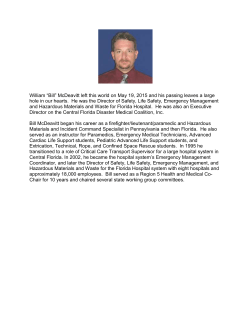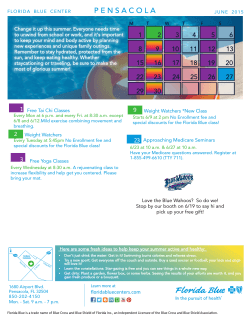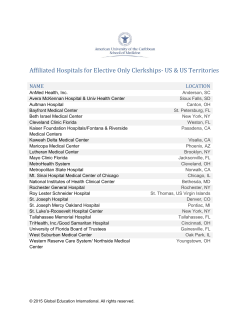
REVENUE ESTIMATING CONFERENCE Tax: Gross Receipts/ Sales
REVENUE ESTIMATING CONFERENCE Tax: Gross Receipts/ Sales and Use Tax Issue: Nuclear Generating Asset Retirement Financing Bill Number(s): CS/HB7109 Section 7, CS/CS/SB288 Section 8 Entire Bill Partial Bill: HB Section 7; SB Section 8 LOCAL IMPACT Sponsor(s): Sen Latvala, Rep La Rosa, Rep Peters Month/Year Impact Begins: July 1, 2015 Date of Analysis: April 23, 2015 x Section 1: Narrative a. Current Law: After the Hurricanes and Tropical storms in 2004 and 2005, a new financing mechanism, called securitization, was created to allow investor-owned electric utilities to petition the PSC to finance storm recovery costs. The purpose of the mechanism was to allow utilities to establish a nonbypassable charge to the utility’s customers and provide a secure stream of revenue payments to the separate legal entity from which the bonds would be paid. b. Proposed Change: The bill creates a similar financing mechanism for investor-owned utilities, subject to the terms of an order of the PSC, approving the creation of “Nuclear Asset-recovery Bonds” to recover certain costs associated with the premature retirement of a nuclear plant. The PSC must find that the utility’s use of the financing mechanism will avoid or significantly mitigate rate impacts to customers as compared with traditional financing methods of recovery for costs. Section 2: Description of Data and Sources Discussions with Public Service Commission http://www.floridapsc.com/library/FILINGS/13/06894-13/06894-13.pdf “The Florida Tax Guide for Municipal Electric Utilities” (page 35) Gross Receipts Charges. Gross receipts charges are not exempt from gross receipts taxes. Gross receipts taxes should be remitted on gross receipt charges included in customer bills, whether or not those charges are separately stated. http://www.publicpower.com/pdf/fmea_tax_guide_for_municipal_utilities_2006.pdf http://dor.myflorida.com/dor/governments/mpst/ http://www.floridapsc.com/utilities/electricgas/statistics/statistics-2012.pdf Section 3: Methodology (Include Assumptions and Attach Details) Please see attached. It is assumed the Nuclear Asset Recovery Charges are Taxable, based on the Florida Tax Guide for Municipal Electric Utilities. In 2013 there was a settlement in Duke Energy vs Public Council setting the valuation of unrecovered costs from CR3’s early retirement at $1.46bn. It is assumed that this site would be the most ready to enact the mechanisms provided in the language and issue Nuclear Asset Recovery Bonds. The impact is derived from approximating current costs of financing under traditional methods and comparing that to the new mechanism’s financing advantages and how those would impact gross receipts, state sales tax and the regulatory assessment fee. Under traditional methods the bond financing rate for AAA Corporate Bonds is 4.59%, according to the NEEC’s latest forecast. Under this new method it is believed that the rate could fall to as low as 2.6%. That equates to a 16.4% decline in financing costs, along with the associated tax revenues. The high estimate is based on an impact beginning January 1, 2017 and the low is based on an impact beginning January 1, 2016. This analysis takes into account only the local portion of the bill. DOR publishes data relating to the tax rates for Public Services across municipalities and counties. The PSC’s “Statistics of Florida Electric Utility Industry” breaks out the counties that Duke Energy is currently operating in the state. An effective rate was calculated at the municipal level and county level in the territories Duke energy operates in. Those effective rates were then weighted by the population and unincorporated vs incorporated populations for their respective rates. For example, the public service tax rate for counties had the unincorporated population of only counties with a tax rate divided by the total population of all counties that Duke Energy operates in. The ratio was then applied against the against the average public service tax rate for counties. Likewise, the same general methodology was applied for the municipal rates. An average franchise fee of 6% was used and weighted against the population incorporated in the appropriate Duke Energy Counties. 445 REVENUE ESTIMATING CONFERENCE Tax: Gross Receipts/ Sales and Use Tax Issue: Nuclear Generating Asset Retirement Financing Bill Number(s): CS/HB7109 Section 7, CS/CS/SB288 Section 8 The Impact that follows is ONLY the franchise fee and public service taxes. The high estimate assumes an effective rate of 10% across the board. The middle estimate is based off industry provided effective rates and the low uses FDEC population statistics and DOR data regarding local data to create a blended rate. Section 4: Proposed Fiscal Impact Local: High Cash Recurring 2015-16 ($1.2m) ($4.7m) 2016-17 ($4.7m) ($4.7m) 2017-18 ($4.7m) ($4.7m) 2018-19 ($4.7m) ($4.7m) 2019-20 ($4.7m) ($4.7m) Cash ($0.7m) ($2.7m) ($2.7m) ($2.7m) ($2.7m) Middle Recurring ($2.7m) ($2.7m) ($2.7m) ($2.7m) ($2.7m) 2015-16 Cash ($1.1m) Middle Recurring ($4.3m) 2016-17 ($4.3m) ($4.3m) 2017-18 ($4.3m) ($4.3m) 2018-19 ($4.3m) ($4.3m) 2019-20 ($4.3m) ($4.3m) Low Cash ($0.4m) ($1.5m) ($1.5m) ($1.5m) ($1.5m) Recurring ($1.5m) ($1.5m) ($1.5m) ($1.5m) ($1.5m) Total High Cash Recurring Low Cash Recurring List of affected Trust Funds: Sales and Use Tax, PECO, Regulatory TF Section 5: Consensus Estimate (Adopted: 04/27/2015): The Conference adopted the middle estimate. GR 2015-16 2016-17 2017-18 2018-19 2019-20 Cash (0.1) (0.4) (0.4) (0.4) (0.4) Recurring (0.4) (0.4) (0.4) (0.4) (0.4) Cash (0.3) (1.2) (1.2) (1.2) (1.2) Trust Recurring (1.2) (1.2) (1.2) (1.2) (1.2) 446 Local/Other Cash Recurring (0.7) (2.7) (2.7) (2.7) (2.7) (2.7) (2.7) (2.7) (2.7) (2.7) Cash (1.1) (4.3) (4.3) (4.3) (4.3) Total Recurring (4.3) (4.3) (4.3) (4.3) (4.3) Principal Asset Value $1,460,000,000 Base Assumptions: Equity Financing @50% Debt Financing @50% 8.12% 4.59% Total Financing Costs over 20 Years* Gross Receipts @2.5% Gross Receipts @2.6% Sales and Use Tax @4.35% Public Service Tax- Municipal @2.75% (Weighted) Public Service Tax- County @1.84% (Weighted) Franchise Fee @2.6% (Weighted) Regulatory Assessment Fee @.072% Total Tax over 20 Years Annualized Gross Receipts Annualized Sales Tax Annualized Public Service Tax Annualized Franchise Fee Annualized Regulatory Assessment Fee $2,631,507,900 $65,787,698 $17,788,993 $29,762,354 $72,366,467 $48,419,745 $68,419,205 $1,894,686 $304,439,149 $4,178,835 $1,488,118 $6,039,311 $3,420,960 $94,734 Total Impact Nuclear Asset Recovery Bond Rate 2.60% Total Financing Costs over 20 Years Gross Receipts @2.5% Gross Receipts @2.6% Sales and Use Tax @4.35% Public Service Tax- Municipal @2.75% (Weighted) Public Service Tax- County @1.84% (Weighted) Franchise Fee @2.6% (Weighted) Regulatory Assessment Fee Total Tax over 20 Years Annualized Gross Receipts Annualized Sales Tax Annualized Public Service Tax Annualized Franchise Fee Annualized Regulatory Assessment Fee $1,890,835,298 $47,270,882 $12,782,047 $21,385,347 $51,997,971 $34,791,369 $49,161,718 $1,361,401 $218,750,736 Difference ($740,672,602) ($18,516,815) ($5,006,947) ($8,377,007) ($20,368,497) ($13,628,376) ($19,257,488) ($533,284) ($85,688,413) $3,002,646 $1,069,267 $4,339,467 $2,458,086 $68,070 ($1,176,188) ($418,850) ($1,699,844) ($962,874) ($26,664) Sales and Use Tax Impact 2015-16 2016-17 2017-18 2018-19 2019-20 ($1,071,105) ($4,284,421) ($4,284,421) ($4,284,421) ($4,284,421) Trust 2015-16 2016-17 2017-18 2018-19 2019-20 ($104,713) ($418,850) ($418,850) ($418,850) ($418,850) 2015-16 2016-17 2017-18 2018-19 2019-20 ($665,680) ($2,662,718) ($2,662,718) ($2,662,718) ($2,662,718) Local 2015-16 ($300,713) 2016-17 ($1,202,852) 2017-18 ($1,202,852) 2018-19 ($1,202,852) 2019-20 ($1,202,852) *Separate bond calculator was used to approximate financing costs 447 Gross Receipts (Reg) Gross Receipts (Swap) Sales and Use Tax Public Service Tax- Municipal Public Service Tax- County Franchise Fee Regulatory Assessment Fee Tax Rates 2.500% 2.600% 4.350% 2.750% 1.840% 2.600% 0.072% REVENUE ESTIMATING CONFERENCE Tax: Sales and Use Tax Issue: Sports Facilities Distributions Bill Number(s): CS/SB 1214 Entire Bill Partial Bill: Section 52 X Sponsor(s): Month/Year Impact Begins: July 1, 2015 Date of Analysis: 4/23/15 Section 1: Narrative a. Current Law: S. 288.11625 provides applicants state funding under s. 212.20(6)(d)6.f. for the public purpose of constructing, reconstructing, renovating, or improving a sports facility. The expected amount of average annual new incremental state sales taxes generated by sales at the facility must be at least $500,000 above the baseline for the applicant to be eligible to receive a distribution under this section. Under s. 288.11625 (6)(a)1‐4. the annual distribution amount an applicant may receive is determined. If the total project cost is $200 million or greater, the annual distribution amount may be up to $3 million. If the total project cost is at least $100 million but less than $200 million, the annual distribution amount may be up to $2 million. If the total project cost is less than $100 million and more than $30 million, the annual distribution amount may be up to $1 million. (6)(d) The department shall notify the Department of Revenue of the applicant’s initial certification, and the Department of Revenue shall begin distributions within 45 days after such notification or upon a date specified by the department as requested by the approved applicant, whichever is later. b. Proposed Change: Effective July 1, 2015, the four sports development project applications reviewed by the DEO and recommended to the Legislature for approval are approved pursuant to s.288.11625(4)(e) F.S. The Department of Economic Opportunity shall certify the applicants for sports development projects no later than August 15, 2015. Section 2: Description of Data and Sources Used distribution amounts found in s. 288.11625(6)(a)1‐4 and the list of applicants from EDR. Section 3: Methodology (Include Assumptions and Attach Details) The four applicants are Daytona International Speedway, LLC which could receive $3 million a year, the South Florida Stadium which could receive $3 million per year, the City of Orlando which could receive $2 million per year, and the City of Jacksonville which could receive $1 million per year. The middle and low estimates reflect a one and two month lag respectively, in distributions. Section 4: Proposed Fiscal Impact High Middle Low Cash Recurring Cash Recurring Cash Recurring 2015‐16 ($9.0m) ($9.0m) ($8.3m) ($9.0m) ($7.5m) ($9.0m) 2016‐17 ($9.0m) ($9.0m) ($9.0m) ($9.0m) ($9.0m) ($9.0m) 2017‐18 ($9.0m) ($9.0m) ($9.0m) ($9.0m) ($9.0m) ($9.0m) 2018‐19 ($9.0m) ($9.0m) ($9.0m) ($9.0m) ($9.0m) ($9.0m) 2019‐20 ($9.0m) ($9.0m) ($9.0m) ($9.0m) ($9.0m) ($9.0m) List of affected Trust Funds: General Revenue Section 5: Consensus Estimate (Adopted: 04/27/2015): The Conference adopted the middle estimate. GR Trust Local/Other Total Cash Recurring Cash Recurring Cash Recurring Cash Recurring 2015‐16 (8.3) (9.0) 0.0 0.0 0.0 0.0 (8.3) (9.0) 2016‐17 (9.0) (9.0) 0.0 0.0 0.0 0.0 (9.0) (9.0) 2017‐18 (9.0) (9.0) 0.0 0.0 0.0 0.0 (9.0) (9.0) 2018‐19 (9.0) (9.0) 0.0 0.0 0.0 0.0 (9.0) (9.0) 2019‐20 (9.0) (9.0) 0.0 0.0 0.0 0.0 (9.0) (9.0) 480 REVENUE ESTIMATING CONFERENCE Tax: Sales and Use/ Corporate/ Ad Valorem Issue: Enterprise Zone Benefits/ 3 year limited extension Bill Number(s): CS/SB 1214 Proposed Amendment Entire Bill Partial Bill: Section 51 Sponsor(s): Month/Year Impact Begins: Date of Analysis: Section 1: Narrative a. Current Law: Currently enterprise zones are going to expire on December 31, 2015 b. Proposed Change: (1) For purposes of this section, the term “eligible business” means a business that entered into a contract with the Department of Economic Opportunity for an economic development program under ss. 288.0659, 288.1045, 288.106, 288.107, 288.108, 288.1088 or 288.1089, Florida Statutes, between January 1, 2012, and July 1, 2015, for a project located in an enterprise zone which was designated pursuant to s. 290.0065, Florida Statutes 2014, as of May 1, 2015. (2) An eligible business may apply to the Department of Economic Opportunity for the following incentives, if the contract with the Department of Economic Opportunity is still deemed active by the department and has not expired or terminated: (a) The property tax exemption for a licensed child care facility under s. 196.095, Florida Statutes 2014. (b) The building materials sales tax refund under s. 212.08(5)(g), Florida Statutes 2014. (c) The business equipment sales tax refund under s. 212.08(5)(h), Florida Statutes 2014. (d) The electrical sales tax exemption under s. 212.08(15), Florida Statutes, 2014. (e) The enterprise zone jobs tax credit under s. 212.096, Florida Statutes 2014. (f) The enterprise zone jobs tax credit under s. 220.181, Florida Statutes 2014. (g) The enterprise zone property tax credit under s. 220.182, Florida Statutes 2014. (3) The Department of Economic Opportunity must provide a list of eligible businesses annually to the Department of Revenue. The Department of Economic Opportunity must also provide notice to the Department of Revenue upon the expiration or termination of a contract. (4) From January 1, 2016 to December 31, 2018, the Department of Economic Opportunity is designated to perform all the duties and responsibilities that were performed by the governing body or enterprise zone development agency having jurisdiction over the enterprise zone under ss. 196.095, 212.08(5) (g) and (h), 212.08(15), 220.181, and 220.182, Florida Statutes 2014, including receipt and review of applications, and certifications. (5) This section is effective January 1, 2016, and expires on December 31, 2018. Section 2: Description of Data and Sources Department of Economic Opportunity (DEO) Enterprise Zone detail reports Property Tax Oversight report on exempt child care facilities Section 3: Methodology (Include Assumptions and Attach Details) This Estimate consists of 6 pieces, one for each type of extended enterprise zone benefit. The basis for much of the analysis comes from detailed reports from the DEO reports on which businesses would be able to apply for the extended benefits. There is a total of 34 eligible businesses. The first section relates to the property tax exemption under s. 196.095. There were 199 facilities exempt in 2013 and 2014. The average exempt value per facility for these two periods was $217,552. The high assumes that 20% of businesses will have a childcare facility with the average value from 2013-14. The middle assumes that 10% of businesses will have a childcare facility with the average value from 2013-14. The low assumes that 5% of businesses will have a childcare facility with the average value from 201314. For the purposes of the estimate it is also assumed the value of the childcare facilities does not change over time. This exemption ends when the proposed language expires, and should affect the tax rolls for 2016, 2017, and 2018. 481 REVENUE ESTIMATING CONFERENCE Tax: Sales and Use/ Corporate/ Ad Valorem Issue: Enterprise Zone Benefits/ 3 year limited extension Bill Number(s): CS/SB 1214 Proposed Amendment The second section relates to the building material sales tax refund under s.212.08 (5) (g). It is assumed that all businesses will be able to take advantage of this refund within the forecast period, and that the refunds will be evenly distributed for the affected periods. The requirements for the refund specify that the refund must be applied for within 6 months of the activity for this reason the affected period is 3 years plus 6 months. The high estimate assumes that that the businesses qualify for $10,000 per parcel due to at least 20% of the employees of the business coming from the enterprise zone, and that there are three parcels per business project. The low estimate assumes that that the businesses qualify for $5,000 per parcel due to less than 20% of the employees of the business coming from the enterprise zone, and that there is one parcel per business project. The middle is the average of the high and the low. The third section relates to the business equipment sales tax refund under s.212.08 (5) (h). Capital investment for eligible businesses is used to find the total investment of $532,534,810 for all projects. ). It is assumed that all businesses will be able to take advantage of this refund within the forecast period, and that the refunds will be evenly distributed for the affected periods. The requirements for the refund specify that the refund must be applied for within 6 months of the activity for this reason the affected period is 3 years plus 6 months. The high estimate assumes an investment window of 4 years and that 50% of capital investment is in business equipment with values greater than $5,000. The middle estimate assumes an investment window of 6 years and that 40% of capital investment is in business equipment with values greater than $5,000. The low assumes an investment window of 8 years and that 30% of capital investment is in business equipment with values greater than $5,000. The fourth section relates to the electrical sales tax exemption under s.212.08(15). The annual enterprise zone report data was used to find the relationship between the electrical sales tax exemption and the rest of the extended benefits. For 2012-13 and 2013-14 the electrical exemption represented and additional 5% on top of the rest of the benefits. The electrical exemption for the estimate is 5% multiplied by the total for the rest of the benefits. The exemption lasts for 5 years, and the 2017-18 value is held constant for 2018-19 and 2019-20. The fifth section consists of the Jobs credit taken against sales and use tax under s.212.096, or against corporate income tax under s.220.181. Detailed data on wages and new employees for the affected business was used as the basis for this estimate. The high assumes that for projects in rural enterprise zones 70% of employees are from the enterprise zone, for projects in Non-Rural enterprise zones 30% of the employees reside in the zone, and that 10% in the welfare transition program from all projects. The middle assumes that for projects in rural enterprise zones 50% of employees reside in the zone, for projects in Non-Rural enterprise zones 20% of the employees reside in the zone, and that 7% in the welfare transition program from all projects. . The low assumes that for projects in rural enterprise zones 19% of employees reside in the zone, for projects in Non-Rural enterprise zones 10% of the employees reside in the zone, and that 4% in the welfare transition program from all projects. For all estimates it is assumed that the welfare transition rate for the credit is 42.5%. It is assumed that 60% of the credits generated are taken against sales tax based on the annual enterprise zone report. The middle is the average of the high and the low. The credit shall be allowed for up to 24 consecutive months. The sixth section consists of the property tax credit under s. 220.182. It is assumed that all businesses will be affected by this credit. It was assumed that 70% of the capital investment amount was real property improvements qualifying for the credit. 2014 Statewide average millage of 18.3703 mills was multiplied to the assumed real property value to obtain maximum property tax per project. The high assumes 3 parcels per business, and that the business employs at least 20% of their workforce from the enterprise zone. Impact was limited to $50,000 per parcel for the high. The low assumes 1 parcel per business, and that the business employs less than 20% of their workforce from the enterprise zone. Impact was limited to $25,000 per parcel in the low. The middle is the average of the high and the low. This credit is granted from 5 years and will first be taken against returns in 2017-18 The proposed language takes effect on January 1, 2016, and expires on December 31, 2018. 482 REVENUE ESTIMATING CONFERENCE Tax: Sales and Use/ Corporate/ Ad Valorem Issue: Enterprise Zone Benefits/ 3 year limited extension Bill Number(s): CS/SB 1214 Proposed Amendment Section 4: Proposed Fiscal Impact Sales and Use Tax High Cash Recurring 2015-16 $(6.1 M) 2016-17 $(8.8 M) 2017-18 $(8.5 M) 2018-19 $(4.6 M) 2019-20 $(1.1 M) Middle Cash Recurring $(3.4M) $(5.2 M) $(4.9 M) $(2.7 M) $(0.7 M) Low Cash $(1.7 M) $(2.4 M) $(2.3 M) $(1.4 M) $(0.4 M) Recurring Corporate Income tax High 2015-16 2016-17 2017-18 2018-19 2019-20 Cash $(1.1 M) $(2.7 M) $(4.0 M) $(2.7 M) $(1.9 M) Recurring Cash $(0.7 M) $(1.6 M) $(2.7 M) $(2.0 M) $(1.4 M) Middle Recurring Low Cash $(0.3 M) $(0.6 M) $(1.4 M) $(1.2 M) $(1.0 M) Recurring Property Tax High Cash 2015-16 2016-17 2017-18 2018-19 2019-20 Recurring (Insignificant) (Insignificant) (Insignificant) (Insignificant) Cash Middle Recurring (Insignificant) (Insignificant) (Insignificant) (Insignificant) Low Cash Recurring (Insignificant) (Insignificant) (Insignificant) (Insignificant) Total High 2015-16 2016-17 2017-18 2018-19 2019-20 Cash $(7.1 M) $(11.5 M) $(12.5 M) $(7.3 M) $(3.0 M) Recurring Cash $(4.1 M) $(6.8 M) $(7.7 M) $(4.7 M) $(2.1 M) Middle Recurring Low Cash $(2.0 M) $(3.1 M) $(3.8 M) $(2.6 M) $(1.3 M) Recurring List of affected Trust Funds: Sales, Corporate, Ad Valorem Section 5: Consensus Estimate (Adopted: 04/27/2015): The Conference adopted the following non-recurring impacts for the individual incentive pieces of the Enterprise Zone Act: Childcare Facilities: Negative Insignificant for FY 2015-16 through FY 2018-19. Building Materials Sales Tax Refund: ($.1m) for FY 2015-16 through FY 2018-19. Business Equipment Sales Tax Refund: ($.8m) for FY 2015-16 through FY 2017-18 and ($.4m) for FY 2018-19. Electrical Energy Sales Tax Exemption: Negative Insignificant for FY 2015-16 and ($.1m) for FY 2016-17 through FY 2019-20. Corporate Income Tax Jobs Credits: FY 2015-16 – ($.3m), FY 2016-17 – ($.7m), FY 2017-18 – ($.6m), FY 2018-19 – ($.3m), FY 201920 – ($.1m) Sales and Use Tax Jobs Credits: FY 2015-16 – ($.2m), FY 2016-17 – ($.4m), FY 2017-18 – ($.4m), FY 2018-19 – ($.2m), FY 2019-20 – ($.1m) Corporate Income Tax Credit for Ad Valorem paid: ($.4m) for FYs 2017-18 through 2019-20. 483 REVENUE ESTIMATING CONFERENCE Tax: Sales and Use/ Corporate/ Ad Valorem Issue: Enterprise Zone Benefits/ 3 year limited extension Bill Number(s): CS/SB 1214 Proposed Amendment GR 2015-16 2016-17 2017-18 2018-19 2019-20 Cash (1.2) (1.9) (2.2) (1.5) (0.8) 2015-16 2016-17 2017-18 2018-19 2019-20 Recurring 0.0 0.0 0.0 0.0 0.0 Trust Cash Recurring (Insignificant) 0.0 (Insignificant) 0.0 (Insignificant) 0.0 (Insignificant) 0.0 (Insignificant) 0.0 Local Option Cash Recurring (0.1) 0.0 (0.1) 0.0 (0.1) 0.0 (Insignificant) 0.0 0.0 0.0 Revenue Sharing Cash Recurring (Insignificant) 0.0 (Insignificant) 0.0 (Insignificant) 0.0 (Insignificant) 0.0 (Insignificant) 0.0 Total Local Cash Recurring (0.2) 0.0 (0.2) 0.0 (0.2) 0.0 (Insignificant) 0.0 (Insignificant) 0.0 484 Local Half Cent Cash Recurring (0.1) 0.0 (0.1) 0.0 (0.1) 0.0 (Insignificant) 0.0 0.0 0.0 Total Cash (1.4) (2.1) (2.4) (1.5) (0.8) Recurring 0.0 0.0 0.0 0.0 0.0 Enterprise Zone Benefits/ 3 Year Limited Extension A 1 2 3 4 5 6 7 8 9 10 11 12 13 14 15 16 17 18 19 20 21 22 23 24 25 26 27 28 29 30 31 32 B Summary of DEO Data Number of Affected businesses Rural - 4 NonRural - 30 Total 34 C New Jobs by year 2016 75 573 648 Section 1. 196.095 Property Tax Exemption for licensed child care facility Millage Rate (School) Millage Rate (Non-School) Millage Rate (total) D 2017 0 265 265 E F 2018 0 279 279 7.4334 10.9369 18.3703 Licensed Child Care Facility Exemptions Exemption Value CY to FY 2013-14 2013 $ 2014 $ 40,513,828 46,071,680 199 $ 199 $ 203,587 $ 231,516 $ $ 43,292,754 199 $ 217,552 Percent of affected businesses Number of affected businesses 2013-14* School impact Non-School impact Total Impact 20% 6.8 High $ $ $ $ 1,479,350 10,997 16,180 27,176 10% 3.4 Middle $ $ $ $ *Assumes no change in exemption value for forecast period. Possible impact for 2016, 2017, and 2018 property tax rolls. *For the purposes of the totals at the bottom the impacts here are added for fiscal years 2016-17, 2017-18, and 2018-19 April 27, 2015 Impact Conference Total Impact Average Exemption Current Exemption Number of Facilities 485 1 739,675 5,498 8,090 13,588 5% 1.7 Low $ $ $ $ 369,838 2,749 4,045 6,794 744,251 846,351 G Enterprise Zone Benefits/ 3 Year Limited Extension 33 34 35 36 37 38 39 40 41 42 43 44 45 46 47 48 49 50 51 52 53 54 55 56 57 58 59 60 61 62 63 64 65 66 67 68 69 70 71 72 73 74 A B Section 2. 212.08(5)(g) building materials sales tax refund High Assumes the business meets the ≥ 20% requirement for EZ employees and there are 3 parcels involved in each project Low assumes the business does not meet the 20% requirement and there is only 1 parcel involved in each project Middle is the average of the High and the Low 34 Affected businesses in all estimates Total impact is evenly distributed across periods available for refund (3 years plus 6 months). Number of Businesses Parcels per Business Refund/ Parcel 34 3 10,000 $ $ High ($10K/parcel) Total per month C D E 34 1 7,500 Low ($5K/parcel) $ $ 1,020,000 $ 24,285.71 $ Monthly value * affected months in each fiscal year High 2015-16 $ 2016-17 $ 2017-18 $ 2018-19 $ 255,000 8,500.00 Affected months 145,714 291,429 291,429 145,714 Middle $ $ $ $ 98,357 196,714 196,714 98,357 Low $ $ $ $ 51,000 102,000 102,000 51,000 Section 3. 212.08(5)(h) Business Equipment Sales Tax Refund Per DEO research files affected businesses will be investing $532.5 M High Assumes 50% spent on Business Equipment with price > $5,000 and a 4 year investment period Middle Assumes 40% spent on Business Equipment with price > $5,000 and a 6 year investment period Low Assumes 20% spent on Business equipment with price > $5,000 and an 8 year investment period Total impact is evenly distributed across periods available for refund (3 years plus 6 months). Total investment Investment periods Years Spending on Business Equipment Spending per Year Sales tax refunds available per year $ $ 2015-16 2016-17 2017-18 2018-19 High $ $ $ $ April 27, 2015 Impact Conference $ F 532,534,810 4 50% 66,566,851 $ 3,994,011 $ 3,994,011 3,994,011 3,994,011 1,997,006 Middle $ $ $ $ 486 2 6 40% 35,502,321 $ 2,130,139 $ 2,130,139 2,130,139 2,130,139 1,065,070 Low $ $ $ $ 8 20% 13,313,370 798,802 798,802 798,802 798,802 399,401 6 12 12 6 G Enterprise Zone Benefits/ 3 Year Limited Extension 75 76 77 78 79 80 81 82 83 84 85 86 87 88 89 90 91 92 A B Section 4. 212.08(15) Electrical Energy Sales Tax Exemption Electrical Energy exemption is approximately 5% of value of the total of the rest Enterprise zone incentives 2.5% applied to the total from all other Enterprise Zone incentives Exemption lasts for 5 years Total incentives 2015-16 2016-17 2017-18 High $ $ $ Electricity exemption 2015-16 2016-17 2017-18 2018-19 2019-20 High $ $ $ $ $ April 27, 2015 Impact Conference C Middle 6,806,818 $ 10,940,551 $ 11,934,152 $ 340,341 547,028 596,708 596,708 596,708 Middle $ $ $ $ $ 487 3 D E Low 3,800,999 $ 7,239,933 $ 6,874,136 $ 1,327,716 2,467,170 2,346,656 Low $ $ $ $ $ 33,193 61,679 58,666 58,666 58,666 190,050 361,997 343,707 343,707 343,707 F G Enterprise Zone Benefits/ 3 Year Limited Extension A 93 94 95 96 97 98 99 100 101 102 103 104 105 106 B C D E Section 5. 212.096 Enterprise Zone Jobs tax credit against Sales and Use Tax and 220.181 Enterprise Zone Jobs credit against corporate tax High assumes either that in rural enterprise zones at least 20% of employees are from the Enterprise zone or that the employees are participating in the welfare transition program making $8 more than the Minimum Wage Low assumes that less than 20% of employees are from the Enterprise Zone The EZ jobs credit against Sales and Use Tax Represents 60% of the Total EZ job Credits Middle is the Average of the High and the Low Credit shall be allowed for up to 24 consecutive months Summary of DEO Data Number of Affected businesses Rural - 4 NonRural - 30 Total 34 New Jobs by year 2016 75 573 648 2017 0 265 265 2018 0 $ 279 $ 279 $ Assumed % Employees per year Residing in Zone Rural Urban High 70% 30% Middle 50% 20% Low 19% 7.5% Assumed % Employees Welfare to Work Rural Urban High 10% 10% Middle 7% 7% Low 2% 2% 114 Calculated credits generated per year - Rural 115 2016 116 2017 117 2018 118 Calculated credits generated per year 119 NonRural 120 2016 121 2017 122 2018 123 124 125 total credits per year 126 2016 127 2017 128 2018 129 2019 130 131 CY to Fy 132 2015-16 133 2016-17 134 2017-18 135 2018-19 136 2019-20 137 High $1,666,718.63 $0.00 $0.00 Middle $1,187,682.71 $0.00 $0.00 Low $305,370.83 $0.00 $0.00 High $3,667,466.04 $2,587,500.95 $1,524,526.02 Middle $2,484,189.26 $1,209,633.09 $1,520,291.23 Low $650,456.24 $316,728.44 $398,070.68 High $5,334,184.67 $7,921,685.62 $4,112,026.97 $1,524,526.02 Middle $3,671,871.98 $4,881,505.06 $2,729,924.31 $1,520,291.23 Low $955,827.07 $1,272,555.51 $714,799.12 $398,070.68 107 108 109 110 111 112 113 April 27, 2015 Impact Conference High $2,667,092.33 $6,627,935.14 $6,016,856.29 $2,818,276.49 $762,263.01 Low $477,913.53 $1,114,191.29 $993,677.32 $556,434.90 $199,035.34 488 4 F Jobs times Average Wage 2016 2017 4,662,150 $ $ 27,678,989 $ 13,477,806 $ 32,341,139 $ 13,477,806 $ G 2018 16,939,178 16,939,178 Enterprise Zone Benefits/ 3 Year Limited Extension 138 139 140 141 142 143 144 145 146 147 148 149 150 151 152 153 154 155 156 157 158 159 160 161 162 163 164 165 166 167 168 169 170 171 A Credit against Sales tax (assumed 60% of total) 2015-16 2016-17 2017-18 2018-19 2019-20 B C D High $1,600,255.40 $3,976,761.08 $3,610,113.77 $1,690,965.90 $457,357.81 Middle $943,501.76 $2,322,637.93 $2,103,160.08 $1,012,413.42 $288,389.51 Low $286,748.12 $668,514.77 $596,206.39 $333,860.94 $119,421.20 Credit Against Corporate (assumed 40% of total) 2015-16 2016-17 2017-18 2018-19 2019-20 High $1,066,836.93 $2,651,174.06 $2,406,742.52 $1,127,310.60 $304,905.20 Middle $629,001.17 $1,548,425.29 $1,402,106.72 $674,942.28 $192,259.67 Low $191,165.41 $445,676.51 $397,470.93 $222,573.96 $79,614.14 Section 6. 220.182 Enterprise Zone Property Tax Credit High Assumes the business meets the ≥ 20% requirement for EZ employees and there are 3 parcels involved in each project Low assumes the business does not meet the 20% requirement and there is only 1 parcel involved in each project Middle is the average of the High and the Low Assumes real property equals 70% of capital investment Uses 2014 Aggregate Millage of 18.3703 For Low uses assumed real property*millage and caps impact at $37,500 Number of Businesses for High Uses assumed real property /3 * millage and caps impact at $50,000 Parcels per Business 34 Affected businesses in all estimates Credit/ Parcel Will not be able to first be taken until 2017-18 Credit is granted for 5 years Annual credit April 27, 2015 Impact Conference 5 F G 34 17 3 1 $ 50,000 $ 25,000 High ($50K/parcel) Low ($25K/parcel) $ 1,604,680 $ 425,000 2015-16 2016-17 2017-18 2018-19 2019-20 2020-21 489 E High $ $ $ $ $ $ 1,604,680 1,604,680 1,604,680 1,604,680 Middle $ $ $ $ $ $ 1,014,840 1,014,840 1,014,840 1,014,840 Low $ $ $ $ $ $ 425,000 425,000 425,000 425,000 Enterprise Zone Benefits/ 3 Year Limited Extension A 172 173 Total Impact 174 175 Year 176 2015-16 177 2016-17 178 2017-18 179 2018-19 180 2019-20 181 182 183 Sales Tax Impact 184 185 Year 186 2015-16 187 2016-17 188 2017-18 189 2018-19 190 2019-20 191 192 193 Corporate Income Tax Impact 194 195 Year 196 2015-16 197 2016-17 198 2017-18 199 2018-19 200 2019-20 April 27, 2015 Impact Conference B C D High* Cash $ $ $ $ $ (7.1 M) (11.5 M) (12.5 M) (7.2 M) (3.0 M) Cash $ $ $ $ $ High* (6.1 M) (8.8 M) (8.5 M) (4.4 M) (1.1 M) Cash $ $ $ $ $ (4.0 M) (6.6 M) (7.2 M) (4.2 M) (1.8 M) Cash $ $ $ $ $ (1.1 M) (2.7 M) (4.0 M) (2.7 M) (1.9 M) 490 6 Cash $ $ $ $ $ (3.4 M) (5.0 M) (4.8 M) (2.5 M) (0.6 M) Cash $ $ $ $ $ Recurring (1.2 M) (1.6 M) (1.6 M) (0.8 M) (0.2 M) Low Recurring (0.6 M) (1.5 M) (2.4 M) (1.7 M) (1.2 M) Recurring (1.4 M) (2.1 M) (2.4 M) (1.5 M) (0.7 M) Low Recurring Middle Recurring G Low Recurring Middle Recurring High* Cash $ $ $ $ $ F Middle Recurring Cash $ $ $ $ $ E Cash $ $ $ $ $ Recurring (0.2 M) (0.4 M) (0.8 M) (0.6 M) (0.5 M) REVENUE ESTIMATING CONFERENCE Tax: Highway Safety Fees Issue: Rural Letter Carriers Bill Number(s): CS/SB 160 Entire Bill Partial Bill: Sponsor(s): Fiscal Policy and Evers Month/Year Impact Begins: Becoming Law Date of Analysis: 4/23/2015 X Section 1: Narrative a. Current Law: Section 316.614, Florida Statutes, provides the “Florida Safety Belt Law” that requires a motor vehicle operator, front seat passengers, and all passengers under 18 years of age to wear safety belts while the vehicle is in motion. b. Proposed Change: Section 316.614, Florida Statutes is amended to read “a rural letter carrier of the United States Postal Service is not required to be restrained by a safety belt while performing duties in the course of his or her employment on a designated postal route.” Section 2: Description of Data and Sources Senate Fiscal Policy 2015 Legislative Bill Analysis CS/SB 160 (3/19/2015) Conversation with North Florida District Representative for the Florida Rural Letter Carriers’ Association Distribution Schedule of Court-Related Filing Fees, Service Charges, Costs, and Fines, including a Recording Fee Schedule, Updated October 2014 Handbook PO-603, Rural Carrier Duties and Responsibilities (11-10-05), available at https://about.usps.com/postalbulletin/2005/html/pb22167/postoffice.html Bureau of Labor Statistics, Occupational Employment Statistics, available at http://www.bls.gov/oes/current/oes435052.htm#st Section 3: Methodology (Include Assumptions and Attach Details) According to the Bureau of Labor Statistics, Florida has approximately 18,000 Postal Service Mail Carriers (as of May 2014). According to the Florida Rural Letter Carriers’ Association, there were approximately 9,000 Rural Mail Carriers in Florida in the same time frame. Because Uniform Traffic Citation data do not include occupation of recipient, of these approximately 9,000 Rural Mail Carriers, it is unknown the number of citations issued for failure to use a safety belt under current administration. Furthermore, United States Postal Service employees are governed by federal regulations that allow for Rural Mail Carriers to not wear a safety belt providing the carrier determines it is safe. The proposed language would align Florida Statute with these Federal regulations. This change would reduce the potential pool of drivers subject to the penalties for failure to wear a safety belt ($30 plus administrative costs [$108.00 total]) resulting in a loss of revenue. Because it is unknown how many citations have been and will be issued for Rural Mail Carriers and under Federal Regulations these citations can be dismissed if challenged (according to the Florida Rural Letter Carriers’ Association citations that have been issued have been done so erroneously because Federal Regulations allow for non-wearing. While a small number who receive these citations do end up paying the fines, most are dismissed), the loss of revenue is insignificant. Section 4: Proposed Fiscal Impact High Cash 2015-16 2016-17 2017-18 2018-19 2019-20 Middle Recurring Cash (Insignificant) (Insignificant) (Insignificant) (Insignificant) (Insignificant) Recurring (Insignificant) (Insignificant) (Insignificant) (Insignificant) (Insignificant) Low Cash Recurring REVENUE ESTIMATING CONFERENCE Tax: Highway Safety Fees Issue: Rural Letter Carriers Bill Number(s): CS/SB 160 List of affected Trust Funds: General Revenue Funds State Courts Revenue Trust Fund State Attorneys Revenue Trust Fund Public Defenders Revenue Trust Fund The Clerks of Court Trust Fund Section 5: Consensus Estimate (Adopted: 04/27/2015): The Conference adopted the proposed impact. 2015-16 2016-17 2017-18 2018-19 2019-20 GR Cash Recurring (Insignificant) (Insignificant) (Insignificant) (Insignificant) (Insignificant) (Insignificant) (Insignificant) (Insignificant) (Insignificant) (Insignificant) Trust Cash Recurring (Insignificant) (Insignificant) (Insignificant) (Insignificant) (Insignificant) (Insignificant) (Insignificant) (Insignificant) (Insignificant) (Insignificant) Local/Other Cash Recurring 0.0 0.0 0.0 0.0 0.0 0.0 0.0 0.0 0.0 0.0 Total Cash Recurring (Insignificant) (Insignificant) (Insignificant) (Insignificant) (Insignificant) (Insignificant) (Insignificant) (Insignificant) (Insignificant) (Insignificant)
© Copyright 2025









